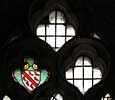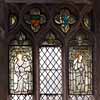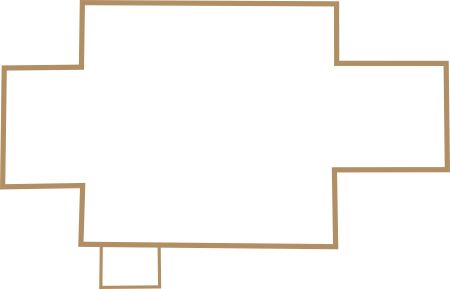For this church:    |
|
Key to Glass |
Writing in 1907, the Revd Arthur du Boulay Hill considered that the glass is generally of the early 14th century, which would make it contemporary with the aisles and chantry. However, more recent opinion tends to identify much of the glass as 19th century, although allowing that some is original 14th century.
Chancel
 Detail Detail |
Window 1 is the north-facing window in the chancel, and the plain lights contain fragments of ancient glass, including heads, drapery and parts of heraldic devices and shields. It is considered that the fragments were put in place by the Revd C. Nevile.
However, some of this glass is of exceptional importance as there are two heads of 12th century date. The June 2013 issue of Vidimus states 'The earliest surviving examples of stained glass in English parish churches have been dated to the first third of the twelfth century. Both are in the Midlands, at Dalbury (Derbyshire) and Fledborough (Nottinghamshire) respectively. The Dalbury glass shows an angel (probably St Michael) and the Fledborough example consists of two heads (one illegible) from an otherwise unknown subject'.
South Aisle
 |
Window 5 is the eastern window in the south aisle, and the shield in the left-hand quatrefoil comprises a white background with two groups of three red martlets (birds) divided by a red band containing three besants (roundels), which are the arms of Wortley. The right-hand shield, showing a black lion and red roses or cinquefoils on a white background, denotes the arms of Pierrepont. Again, the canopy tops in the left and right hand lights are thought to comprise ancient glass, and the glass in the outer traceries may be mostly original. The lights themselves are plain.
6. Window 6 is the central window in the south aisle. The shield in the left hand quatrefoil has a blue background, with a white band between three gold lions; the arms of Bolingbroke. The right hand shield has black and white quarters divided by a red band, representing the Everingham family of Lincolnshire. The vividly coloured main lights have no inscription, but Wilkinson notes on an Elizabethan chalice then in the church safe, the inscription: 'This cup and the stained glass window in the south aisle were presented to this Church as a thankoffering by the Parishioners for their merciful exemption from the Cholera, 1849. Fledborough.’
Window 6 is the central window in the south aisle. The shield in the left hand quatrefoil has a blue background, with a white band between three gold lions; the arms of Bolingbroke. The right hand shield has black and white quarters divided by a red band, representing the Everingham family of Lincolnshire. The vividly coloured main lights have no inscription, but Wilkinson notes on an Elizabethan chalice then in the church safe, the inscription: 'This cup and the stained glass window in the south aisle were presented to this Church as a thankoffering by the Parishioners for their merciful exemption from the Cholera, 1849. Fledborough.’
7. Window 7 is the western window in the south aisle, and the shield in the left-hand quatrefoil comprises a red border with a white centre, which are thought to be the arms of Hunt. The right-hand shield, of blue with a chevron of white, are thought to denote the arms of Lodbroke of Warwickshire. The glass in the outer traceries may be mostly original, and the canopy tops in the left hand and central lights are thought to comprise medieval glass, showing crocketed finials. The lights themselves are plain.
Window 7 is the western window in the south aisle, and the shield in the left-hand quatrefoil comprises a red border with a white centre, which are thought to be the arms of Hunt. The right-hand shield, of blue with a chevron of white, are thought to denote the arms of Lodbroke of Warwickshire. The glass in the outer traceries may be mostly original, and the canopy tops in the left hand and central lights are thought to comprise medieval glass, showing crocketed finials. The lights themselves are plain.
Tower
9.
 |
North Aisle
Windows 10-14 are located in the north aisle. All have heraldic glass depicting the alliances of the Lisieux family in the form of shields, in the quatrefoils at the heads of the aisle windows. Du Boulay Hill thought the glass to be 14th century: Truman, however, states that it was constructed by a Bristol firm, on the instruction of the Revd Charles Nevile, rector between 1852 and 1877, although probably based on what was originally there. It is possible that the glass into which the shields are set, where stained, is original 14th century.
10. The glass in the left-hand quatrefoil of Window 10 (the west-facing window in the north aisle) depicts the arms of Furnival, comprising two groups of three red martlets (birds) divided by a red band, on a white background. The other quatrefoil in this window is blank, as are the main lights, although there is a small amount of stained glass in the canopy tops of the main lights, which may be original.
The glass in the left-hand quatrefoil of Window 10 (the west-facing window in the north aisle) depicts the arms of Furnival, comprising two groups of three red martlets (birds) divided by a red band, on a white background. The other quatrefoil in this window is blank, as are the main lights, although there is a small amount of stained glass in the canopy tops of the main lights, which may be original.
11. The glass in the left-hand quatrefoil of Window 11 (the western of the north-facing windows in the north aisle) depicts the arms of Lisieux, being of gold below with a band of blue above. That in the right-hand quatrefoil shows a blue griffin on a white background, which may represent the arms of Culcheth, a Cheshire family. The glass in the outer traceries may be original, and Truman considers that the glass in the north and south lights is largely original although the heads are probably 19th-century. The west light depicts Our Lady and Child. She holds Him in her left arm and He looks down with outspread hands, His sleeves are rolled to the elbow, with a tight, buttoned cassock and bare feet. The north light, a companion to the south light, depicts a fair-haired female saint with her right hand on her breast, carrying a book in her left hand. Both lights have a low canopy with a crocketed arch, touched with yellow stain.
The glass in the left-hand quatrefoil of Window 11 (the western of the north-facing windows in the north aisle) depicts the arms of Lisieux, being of gold below with a band of blue above. That in the right-hand quatrefoil shows a blue griffin on a white background, which may represent the arms of Culcheth, a Cheshire family. The glass in the outer traceries may be original, and Truman considers that the glass in the north and south lights is largely original although the heads are probably 19th-century. The west light depicts Our Lady and Child. She holds Him in her left arm and He looks down with outspread hands, His sleeves are rolled to the elbow, with a tight, buttoned cassock and bare feet. The north light, a companion to the south light, depicts a fair-haired female saint with her right hand on her breast, carrying a book in her left hand. Both lights have a low canopy with a crocketed arch, touched with yellow stain.
12. The glass in the left-hand quatrefoil of Window 12 (the middle window in the north aisle) also contains the Lisieux arms, and the right hand depicts a shield strewn with crosses and three red roses or cinquefoils on a white background, being the arms of Saltmarshe, of Yorkshire, Lincolnshire and Warwickshire. Although Truman considers the arms to be 19th century, he states that the grounds, borders, and shafts depicted at the base of the west light, are original [14th century], and the glass in the outer traceries may be original
The glass in the left-hand quatrefoil of Window 12 (the middle window in the north aisle) also contains the Lisieux arms, and the right hand depicts a shield strewn with crosses and three red roses or cinquefoils on a white background, being the arms of Saltmarshe, of Yorkshire, Lincolnshire and Warwickshire. Although Truman considers the arms to be 19th century, he states that the grounds, borders, and shafts depicted at the base of the west light, are original [14th century], and the glass in the outer traceries may be original
13.The glass in the left-hand quatrefoil of Window 13 (the eastern of the north-facing windows in the north aisle) also contains the Lisieux arms. The right hand shows a shield with six gold lozenges on a red ground, which is the coat of arms of Rivers or Andrew. The glass in the outer traceries may be original. The main lights show Christ flanked by St John the Divine and St John the Evangelist, and commemorate the Revd C. Nevile, rector between 1852 and 1877.
14.Window 14 (the east-facing window in the north aisle) has three quatrefoils with heraldic devices. The topmost shows a white shield with three black bars, being the arms of Bussey. The shield in the right-hand quatrefoil depicts a gold lion with two tails on a red field, which are the arms of Burghersh. The shield in the left-hand quatrefoil has a red saltire and birds on a white field: it is notably more faded than the other heraldic devices at Fledborough, and although Truman considers it to be 19th century, it is considered that it may be 14th century.
Window 14 is unusual in having its centre light filled with masonry, with a canopied niche. The topmost portion of the centre light remains in situ, and depicts a spire with a knob on the summit. The right hand light has figures of the Virgin and Child (the Child’s right arm, with a bird, being 19th century, and the Virgin’s left hand having been wrongly inserted). Below these figures is a knight in armour, holding up a club and the cross hilt of his sword (the armour is mostly 19th century). In the left hand light the upper figure represents St John the Baptist, with his hair garment indicated. Below is St Andrew. The cross may be 19th century, but the Revd Arthur du Boulay Hill considered it likely that it had been suggested by the old fragments. The inscription reads:
| ET IN IHM XPM FILIU EJUS UNICU DNM NOSTRU |
– ‘And in Jesus Christ His only Son, our Lord’. This is likely to refer to the legend that each Apostle contributed one of the twelve articles of the Creed, St Andrew, second on the list, bearing the second article. Du Boulay Hill considers it likely that the windows originally contained figures of the twelve Apostles with the twelve articles of the Creed as a consecutive series.
 Window 14 Window 14 |
 John the John theBaptist |
 Virgin and Virgin andChild |
 St Andrew St Andrew |
 Knight in Knight inarmour |
This window is all on green-white glass. Each of the figures is within a rounded battlement arch topped by a short plain spire, except the knight, where the arch is crocketed.








